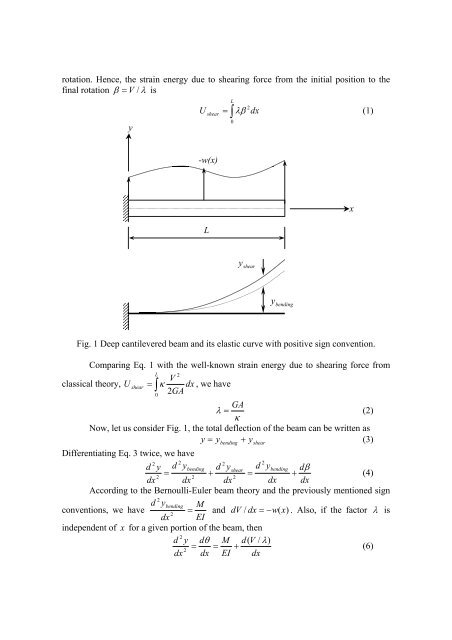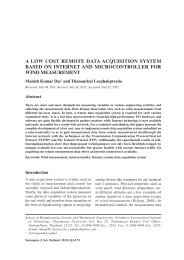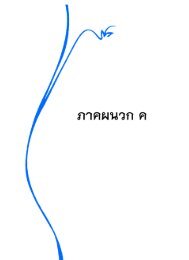Modified Moment-Area Method for Deep Cantilever Beams
Modified Moment-Area Method for Deep Cantilever Beams
Modified Moment-Area Method for Deep Cantilever Beams
You also want an ePaper? Increase the reach of your titles
YUMPU automatically turns print PDFs into web optimized ePapers that Google loves.
otation. Hence, the strain energy due to shearing <strong>for</strong>ce from the initial position to the<br />
final rotation β = V / λ is<br />
y<br />
U<br />
shear<br />
-w(x)<br />
L<br />
=<br />
L<br />
∫<br />
0<br />
2<br />
λβ dx<br />
(1)<br />
yshear<br />
ybending<br />
Fig. 1 <strong>Deep</strong> cantilevered beam and its elastic curve with positive sign convention.<br />
Comparing Eq. 1 with the well-known strain energy due to shearing <strong>for</strong>ce from<br />
L 2<br />
V<br />
classical theory, U shear = ∫κ<br />
dx , we have<br />
2GA<br />
0<br />
λ<br />
κ<br />
GA<br />
= (2)<br />
Now, let us consider Fig. 1, the total deflection of the beam can be written as<br />
y = ybending<br />
+ yshear<br />
(3)<br />
Differentiating Eq. 3 twice, we have<br />
2 2<br />
2<br />
d y d ybending<br />
d yshear<br />
= +<br />
2<br />
2<br />
2<br />
dx dx dx<br />
2<br />
d ybending<br />
dβ<br />
= +<br />
dx dx<br />
(4)<br />
According to the Bernoulli-Euler beam theory and the previously mentioned sign<br />
2<br />
d ybending<br />
conventions, we have 2<br />
dx<br />
M<br />
= and dV / dx = −w(<br />
x)<br />
. Also, if the factor λ is<br />
EI<br />
independent of x <strong>for</strong> a given portion of the beam, then<br />
2<br />
d y dθ<br />
M d(<br />
V / λ)<br />
= = +<br />
2<br />
dx dx EI dx<br />
(6)<br />
x






